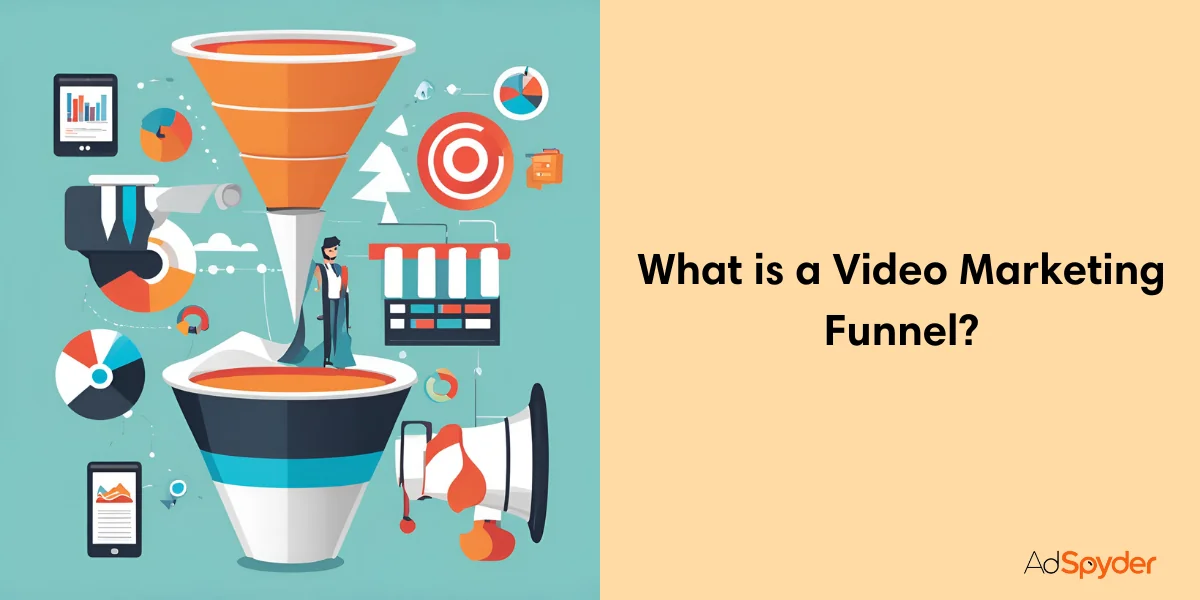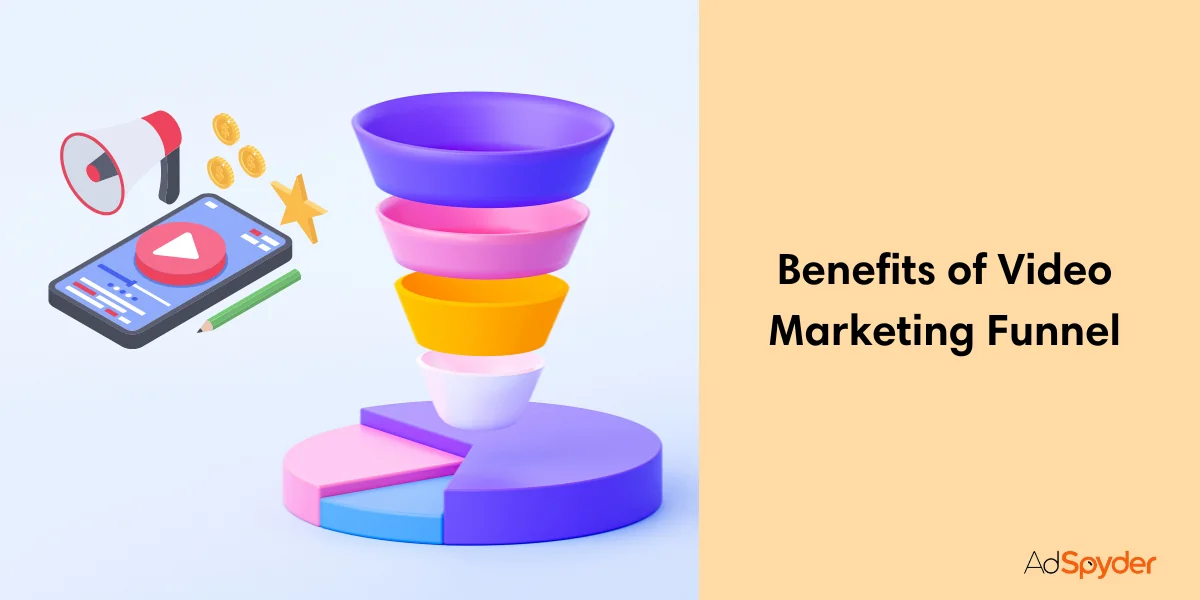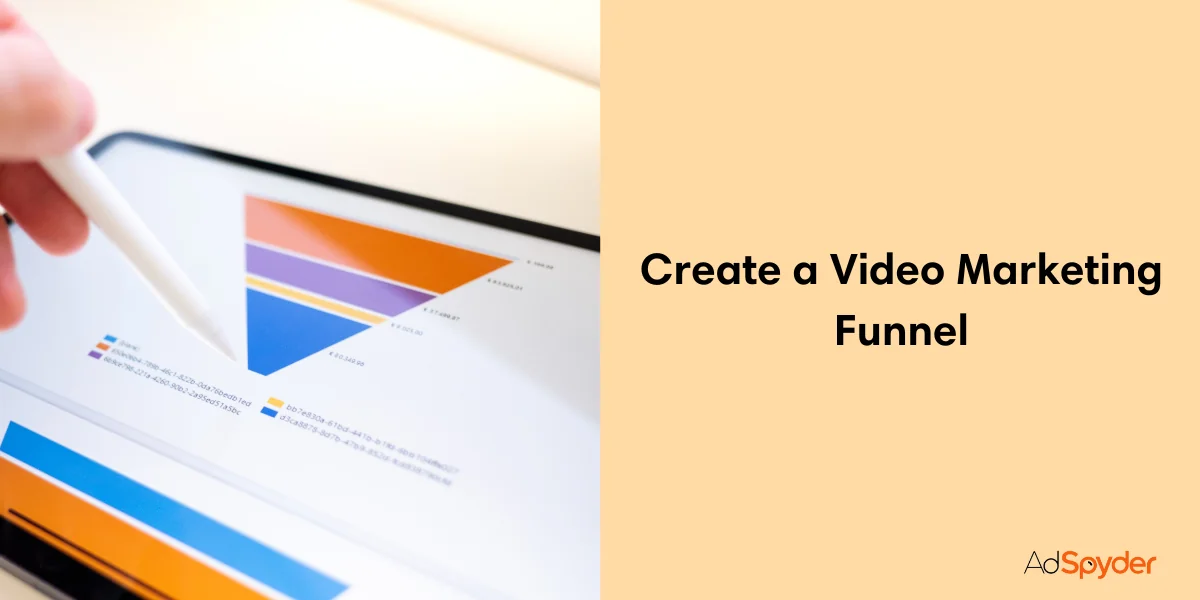Turning viewers into customers is tough for many companies. Yet, 91% of them use video marketing to help. This guide explains how to make a funnel that increases customer conversion. Videos work well in funnels because they grab attention. They fit at every stage, from making people aware of your brand to getting them to buy. To truly harness the power of video marketing, you need a strategic approach – a video marketing funnel. In this blog, we’ll focus on providing valuable insights and actionable steps to build an effective funnel.
Ready to Elevate your Marketing Strategy?
Summary
- Unlock the True Potential of Video Marketing Funnels: Learn how to create a winning video marketing funnel, from understanding your audience to creating compelling video content for every stage in this post.
- Make Your Videos Engaging and Then Optimize Them: How you will optimize your videos for search engines, effectively promote them across multiple channels to maximum visibility and maximum engagement.
- Measure & Analyze for Improvement: Get to know what KPIs to look out for so you can measure your video marketing funnel and know where to improve.
- Protect Yourself Against the Most Common Pitfalls and Adopt the Best Practices: Learn the common mistakes made during video marketing that are most likely to affect your sales, and learn some valuable best practices that will help you make the most of your videos.
Video Marketing Funnel Essentials
Video marketing moves people from knowing your brand to buying from it. It’s a key step in the customer journey, helping turn interest into sales.
What is a Video Marketing Funnel?

A Video Marketing Funnel is a strategy that shows your videos to people at different stages of their buying journey.
- It helps grab attention, teach, and persuade them to buy or support your brand.
- The funnel includes TOFU (Top of the Funnel), MOFU (Middle of the Funnel), BOFU (Bottom of the Funnel), and Retention stages.
- Each stage matches a step in someone’s path from learning about you to becoming a loyal customer.
- Videos guide consumers through steps toward making a purchase, like guiding water through a funnel.
- This plan boosts sales funnel efficiency, aids in lead generation, and enhances conversion rates.
- It covers the entire customer journey, improving marketing strategy and brand awareness.
Through engaging video content, it keeps audiences interested and encourages customer retention as part of an effective content marketing strategy.
Benefits of a Video Marketing Funnel

A video marketing funnel helps turn viewers into customers. It does this by making your brand’s story more interesting, engaging people better, and showing clear outcomes. Use it to see real benefits in customer conversion and brand awareness.
Increased Engagement
Videos catch your eye better than text. They are fun and keep you watching. Since people quickly lose focus, videos have to grab them fast. They make you feel part of the story, so you stick around longer and remember more.
Words like “engaging” and “compelling” show why video marketing is so strong. Videos aren’t just for watching; they bring viewers into the action. This connection helps hold attention even with lots of online distractions.
Improved Brand Storytelling
Stories boost engagement in marketing. They make your brand pop.
- Brands like Nike and Airbnb use stories well. Their videos touch people’s hearts, helping build trust.
- Only 23% of folks trust brands, so this trust matters.
- A video marketing funnel brings stories into every step to draw people to your brand. Product explainers set up awareness by making viewers feel they belong in your world.
- Since 76% of marketers report that video increases sales, storytelling through video plays a big role in success.
Enhanced Conversions
Videos improve brand storytelling and boost conversion rates.
- Sales videos with clear calls to action push viewers to act, turning them into buyers or subscribers.
- This increases sign-ups, leads, and sales for your business.
- For better performance at the bottom of the funnel, track how well your videos perform.
- Monitor sign-ups and sales from each video to identify which ones are most effective at moving customers to take action.
Measurable Results
Video marketing funnels help track progress. They use clear measurements and key performance indicators (KPIs).
- At the beginning, you check how many people watch your videos and how they interact with them.
- In the middle, you focus on how long they watch. For keeping customers, both the number of views and watch time matter.
- These tools show us how people act and if our videos do their job well. We can spot what works and fix what doesn’t.
- This way, making our strategy better for tomorrow is easy. By looking at these specific outcomes, businesses can shape their video content better at every level for great results in marketing.
Steps to Create a Video Marketing Funnel

There are certain clear steps when it comes to creating a video marketing funnel. This will ensure that your video marketing funnel captures the attention of the shoppers, and guide them from discovery to purchase. Whether you are starting a dropshipping venture, or a well established brand, video marketing funnel allows for streamlining your video content for marketability. To begin with, you need to set objectives and understand who your audience is.
Step 1: Define Your Goals & Audience
- First, you need to define the purpose of the videos you are going to create and use.
- It could be that you need more individuals to visit your brand or to buy more products.
- Determine what they expect, what they lack, and in what manner they receive general and specific information.
- Create videos that answer their questions and address their needs whenever they are in their buying process cycle.
Step 2: Content Strategy for Each Funnel Stage
- Making a video content strategy helps guide customers on their journey.
- It means making video content that meets the needs and interests of your audience at different stages.
Top of the Funnel (ToFu) Videos:
- Aim to bring in lots of viewers.
- Use how-to videos, educational content, and stories about your brand to catch people’s attention.
- Make videos easy to share for more reach.
- Show how your product or service can fix problems without pushing too hard to sell.
Middle of the Funnel (MoFu) Videos:
- Focus on people who like your brand but aren’t ready to buy yet.
- Create videos that show why your product or service is useful.
- Include customer stories, case studies, and detailed demos of what you offer.
- Spend 40% of your effort here to keep leads interested.
Bottom of the Funnel (BoFu) Videos:
- Target people thinking about buying.
- Make videos that get them to try something free or book a consultation.
- Show how you’re different from others and what makes you better.
- Share success stories from customers and special offers for that last nudge. Use UGC videos to boost your trust and reputation.
Step 3: Video Production & Optimization
To create a video marketing funnel, follow these steps:
- Start with writing a script. Pay attention to what is interesting to your audience.
- Storyboard to organize the visualization of the video.
- Ensure to record high-quality videos especially with regard to lighting and sound for better quality videos.
- Include animated explainer videos to explain the ideas.
- Edit videos carefully. Delete unnecessary scenes and utilize the effects which assist in understanding the plot.
- Improve audio quality with professional gear or get help from an expert.
- Include keywords in titles, descriptions, and tags to make your videos easier to find.
- Repurpose your video content for other marketing avenues. This will bring down your cost of marketing.
Then, promote these optimized videos well to reach more people.
Step 4: Promote & Track Your Videos
Promote your videos well in order to get the most out of your video marketing funnel—this helps send videos to the right people and to know how well they are faring.
- Share your videos on Facebook, Instagram, and Twitter to get more views.
- Run paid ads on these platforms so your content will get to people who will like it.
- You might want to consider putting a video up on your web site and having it done in emails to current customers.
- Connect only with influencers who will help to share your videos with more people.
- You can also use AI in your advertising and determine which part of the funnel works well and which parts can be improved.
Step 5 Promotion Strategies
To make your video marketing funnel work best, use these strategies. They help more people watch your videos and get them to act.
- Post videos on Facebook, Twitter, and Instagram to reach more people.
- Send videos through email to talk directly to your subscribers.
- Work with influencers and top people in your field to connect with their fans and seem more trustworthy.
- Make sure search engines like Google can find your videos by using the right words in titles, descriptions, and tags.
Doing all this makes sure the right customers see your videos. It also pushes them ahead to become happy customers.
Case Study Examples: Applications of Video Marketing Funnels in the Real World
However, to appreciate the potency of video marketing funnels and how they work, it helps to evaluate case studies. Here are examples of how different organizations have incorporated video marketing to increase the chances of converting their customers, increase interaction and sales. This way, you can get some practical tips and even some real-life case studies to take away from this and apply to your own video marketing. Now, it is high time to dive deeper into the examples of how brands have built and fine-tuned their video marketing funnels to get outstanding outcomes.
Case Study 1: HubSpot
Overview:
HubSpot which is an inbound marketing and sales software company employed video marketing to create awareness and to convince the target customers, thus enhancing its market authority.
Strategy:
- TOFU (Top of the Funnel): To help educate people about inbound marketing, SEO, and social media strategies, HubSpot developed a set of videos that expounded on the concepts. These videos were posted on their YouTube channel and in the blogs through embedding to get a wider audience.
- MOFU (Middle of the Funnel): They came up with well-annotated case studies, product demonstrations, and customer success stories to support their tools and services. These kept the audience informed, engaged, and trusting through the real-life use cases of HubSpot’s products.
- BOFU (Bottom of the Funnel): Targeted videos and free trials were then sent to the leads who had interacted with their educational content to urge them to sign up for HubSpot.
Results:
- Grow the total number of subscribers of the YouTube channel by 40%.
- Increased sign-up rate by 25% with the use of personalized video offers
- Higher user engagement through the consistent provision of educational video materials.
Case Study 2: GoPro
Overview:
GoPro, which is an action camera company, effectively made use of user-generated content and storytelling to create a powerful video marketing funnel.
Strategy:
- TOFU: GoPro urged people to upload their thrilling videos shot with GoPro cameras and, thus, built an inspiring collection of real-life videos. These videos that were created by the users were shared on GoPro’s YouTube and other social media accounts and got a lot of views.
- MOFU: These included instructional videos on how to use the GoPro cameras to the optimum, as well as ‘making of’ clips of athletes and adventurers using the GoPro products. These videos focused on the flexibility and credibility of GoPro cameras.
- BOFU: Web advertisements included promotional videos and special offers that were aimed at the viewers who had engaged with their content by using GoPro cameras and accessories to purchase more equipment.
Results:
- Increased the YouTube subscribers to over 10 million
- Raised the sales by 35% by creating the promotional videos that are appealing to the targeted audience
- Maintaining user engagement and community building to make the brand more loyal.
Case Study 3: Moz
Overview:
Moz, a company that deals with SEO tools, employed video as a way of educating the consumers and thus, selling to them by offering them insights on the industry.
Strategy:
- TOFU: Moz then came up with a program called ‘Whiteboard Friday’ where different people were invited to explain different SEO matters in simple ways. These educational videos received a large viewership of people who wanted to know more about SEO.
- MOFU: They created cases and detailed lessons on how their tools can be used to address certain SEO issues. These videos also contributed to earning Moz’s trust and showing the relevance of its solutions.
- BOFU: Special offers and demonstration videos were provided to the viewers who watched educational materials, in order to attract them to use Moz tools for their projects.
Results:
- Generated 25% more traffic to the website through videos.
- Increased the conversion rates by 20% through the trial offers that are targeted.
- Improving customers’ satisfaction and loyalty through a series of educational videos.
- These new examples are aimed at showcasing the variety of strategies to construct and enhance video marketing funnels. Studying these cases and adapting strategies for your brand, you can use video marketing to increase customer conversion and get excellent outcomes.
These new case studies illustrate diverse approaches to building and optimizing video marketing funnels. By learning from these examples and tailoring their strategies to fit your brand’s needs, you can effectively leverage video marketing to drive customer conversion and achieve outstanding results.
FAQs
If the presentation requires a detailed explanation of a particular concept, then, 2-5 minutes at most. 2 minutes or less is ideal if you want to have as direct a call to action as possible.
It is possible to create high-quality videos at a low cost. Stock footage and images should be relied upon – there are both free and paid services available.
– Snackables for social media.
– Grab the audio for a podcast episode
– Script out your post.
– Infographic with the highlights.
The frequency of posting videos depends upon your audience. Ensure that you are consistently posting the video whether you are considering weekly or bi-weekly.
Yes. Here are some B2B-specific video marketing strategies:
– Create explainer videos for complex products or services.
– Showcase customer success stories to build trust with potential clients.
Conclusion
Recap
By creating the video marketing funnel, it becomes easier to convert the viewers into the customers. Second, it is very important to understand your objectives and the target audience. It is recommended to make videos for all the steps of the funnel. Make sure your videos are indexed where people can find them. It would also be important to monitor their performance to see how well they are doing. This guide illustrates how businesses can expand through the use of videos. Understand your target audience. Produce videos that correspond to every phase in the client-acquiring process. Additionally, figure out the appropriate sites for posting the videos while observing the performance of the videos.
Final Thoughts
Video marketing is one of the effective marketing strategies that can help you attain your marketing objectives. With an effective video marketing funnel in place, you can grab the attention of a new audience,and persuade them to become paying customers. Just remember that consistency, focusing on your audience, and data-driven optimization are the ways to get the most out of your video marketing efforts.
Call to Action
This blog post unpacked a powerful tool: the video marketing funnel. We walked you through each step, from understanding your target audience to crafting impactful videos for every stage. You learned optimization secrets to make your videos shine in search results and discovered promotion strategies to get them seen by the right viewers. Now, equipped with this knowledge, are you ready to transform your marketing efforts? Let’s celebrate the power of video marketing you’ve unlocked!




